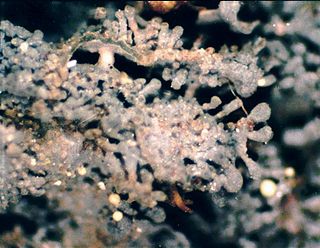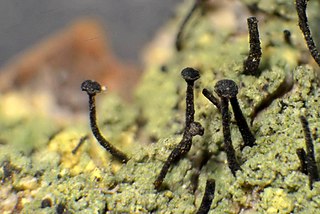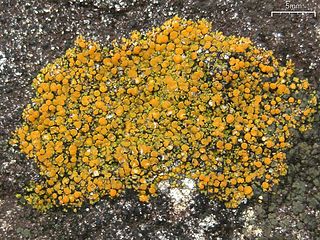
A lichen is a composite organism that arises from algae or cyanobacteria living among filaments of multiple fungi species in a mutualistic relationship. Lichens have properties different from those of their component organisms. They come in many colors, sizes, and forms and are sometimes plant-like, but lichens are not plants. They may have tiny, leafless branches (fruticose); flat leaf-like structures (foliose); crust-like, adhering tightly to a surface (substrate) like a thick coat of paint (crustose); a powder-like appearance (leprose); or other growth forms.
Lithophiles are micro-organisms that can live within the pore interstices of sedimentary and even fractured igneous rocks to depths of several kilometers.
This glossary of botanical terms is a list of definitions of terms and concepts relevant to botany and plants in general. Terms of plant morphology are included here as well as at the more specific Glossary of plant morphology and Glossary of leaf morphology. For other related terms, see Glossary of phytopathology and List of Latin and Greek words commonly used in systematic names.

An isidium is a vegetative reproductive structure present in some lichens. Isidia are outgrowths of the thallus surface, and are corticated, usually with a columnar structure, and consisting of both fungal hyphae and algal cells. They are fragile structures and may break off and be distributed by wind, animals, and splashing raindrops. In terms of structure, isidia may be described as warty, cylindrical, clavate (club-shaped), scale-like, coralloid (coral-shaped), simple, or branched.

Acarospora is a genus of lichenized fungi in the family Acarosporaceae. Most species in the genus are crustose lichens that grow on rocks in open and arid places all over the world. They may look like a cobblestone road or cracked up old paint, and are commonly called cobblestone lichens or cracked lichens,. They usually grow on rock, but some grow on soil (terricolous) or on other lichens. Some species in the genus are fungi that live as parasites on other lichens. Acarospora is a widely distributed genus, with about 128 species according to a 2008 estimate.

The Caliciaceae are a family of mostly lichen-forming fungi belonging to the class Lecanoromycetes in the division Ascomycota. Although the family has had its classification changed several times throughout its taxonomic history, the use of modern molecular phylogenetic methods have helped to establish its current placement in the order Caliciales. Caliciaceae contains 36 genera and about 600 species. The largest genus is Buellia, with around 300 species; there are more than a dozen genera that contain only a single species.

Kalapuya brunnea is a species of truffle in the monotypic fungal genus Kalapuya. The truffle occurs only in the Pacific Northwest region of the United States, in western Oregon and northern California. Known locally as the Oregon brown truffle, it was formerly thought to be an undescribed species of Leucangium until molecular analysis demonstrated that it was distinct from that genus. The truffle is reddish brown with a rough and warty outer skin, while the interior spore-producing gleba is initially whitish before developing greyish-brown mottling as it matures. Mature truffles have an odor resembling garlicky cheese, similar to mature Camembert. The species has been harvested for culinary purposes in Oregon.
Terete is a term in botany used to describe a cross section that is circular, or like a distorted circle, with a single surface wrapping around it. This is usually contrasted with cross-sections that are flattened, with a distinct upper surface that is different from the lower surface. The cross-section of a branch in a tree is somewhat round, so the branch is terete. The cross section of a normal leaf has an upper surface, and a lower surface, so the leaf is not terete. However, the fleshy leaves of succulents are sometimes terete. Fruticose lichens are terete, with a roughly circular cross section and a single wrap-around skin-like surface called the cortex, compared to foliose lichens and crustose lichens, which have a flattened cross section with an upper surface that is distinct from the lower surface.

Areolate lichens are crustose lichens that appear to be broken up into somewhat polygonal pieces like old cracked paint. The pieces are called aereolas (areaeolae). The appearance is similar to the island-like pieces of dried-cracked mud in a dry lakebed. The areaolae "islands" are connected by an underlying prothallus to make a single lichen organism. The prothallus is often dark and not noticeable, whereby the different aereolae appear to be disconnected. Sometimes the aereolae curl up at the edges and continue growing at the edges so that they overlap, which is called being squamulose.
Caloplaca durietzii, or Durietz's orange lichen, a smooth surfaced yellowish orange crustose areolate lichen with elongated lobes that grows on wood or bark in southwestern North America. It is commonly seen growing on old junipers in Joshua Tree National Monument in the Mojave Desert. It is in the Caloplaca fungus genus of the Teloschistaceae family.

Lecanora muralis(Protoparmeliopsis muralis) is a waxy looking, pale yellowish green crustose lichen that usually grows in rosettes radiating from a center (placodioid) filled with disc-like yellowish-tan fruiting bodies (apothecia). It grows all over the world. It is extremely variable in its characteristics as a single taxon, and may represent a complex of species. The fruiting body parts have rims of tissue similar to that of the main nonfruiting body (thallus), which is called being lecanorine. It is paler and greener than L. mellea, and more yellow than L. sierrae. In California, it may be the most common member of the Lecanora genus found growing on rocks (saxicolous).
Circinaria arida is a 0.5–6 cm, light olive-brown custose lichen that grows on rock, often like a cluster of little light brown to olive balls growing on pebbles, in the southwestern deserts of North America. It is also found in Eurasia, and arid parts of North America from the southern Great Plains and Midwest to California. It is warty (verrucose) with the warts sometimes cracking apart areolate. The warts or areolas have angular to rounded sides. The 0.2-2.3 mm, convex to flat-topped areolas are separated by deep fissures that may be as deep (0.1–2 mm) as the areaola is wide, so the lichen often appears to be made of clusters of little balls crammed up next to each other, although the areolas are sometimes isolated. In California it is commonly found growing on pebbles. Each areola has a single sunken black, dust covered (pruinose) fruiting body (apothecium) with a white rim. A thin strip of prothallus sometimes is at the outer edge, forming a narrow dark zone (fimbriate). The similar Aspicilia desertorum has a white pruina on the apothecia. It is negative for lichen spot tests, I-, K-, P-, C-.

Aspicilia phaea is a grayish brown to tan areolate crustose lichen commonly found on rock in coastal to inland parts of central and southern California. Described as new to science in 2007, it is endemic to California. It grows on exposed or partially shaded siliceous rock, with a few known occurrences on serpentine rock.
Acarospora veronensis is a medium brown to dark brown or black crustose lichen that grows up to 4 cm (1.6 in) wide. It is extremely variable in its growth forms, being verruculose, rimose, areolate, or squamulose. It has 0.2–1.5 mm round to angular areoles which may be lobed, and may be contiguous or dispersed. It grows on acidic rocks, basalt, and sometimes on wood. It is one of the most common members of its genus in the Sonoran Desert region, common in Arizona, southern California, Baja California north and south, Sonora, to outside the region in Durango. Each areole bears one to many 0.1–1 mm rounded to angular apothecia that are deeply immersed in the areole, with a dull reddish-brown flat to convex disc. Cylindrical asci have 100 or more ellipsoid ascospores. Lichen spot tests are all negative, and it is UV-. It is an indicator of undisturbed soil habitats. Sometimes specimens may look like Acarospora strigata.

Aspicilia cinera is a gray to almost white, 1.5 – 15 cm wide, crustose areolate lichen with large apothecia that mostly grows on rock in the mountains. It grows in variable forms, from having a continuous surface to being areolate. It grows in Eurasia, and North America on siliceous rock, schist or igneous rock in habitats exposed to sunlight, also rarely on calciferous rock. It is common in Arizona, and rare in California and Baja California at elevations of 1,700 to 3,300 metres.
Lecanora vainioi is a species of crustose lichen in the family Lecanoraceae. It is found in Brazil, where it grows on granitic rocks. It was described as a new species in 1986 by Finnish botanist Heino Vänskä. The epithet vainioi honours lichenologist Edvard Vainio (1853–1929), who did pioneering work on the Brazilian lichens.

Protoparmelia badia is a species of crustose lichen in the family Parmeliaceae. It is a widely distributed, common species that grows on rocks.

A fissure is a long, narrow crack opening along the surface of the Earth. It is derived from the Latin word fissura, which means 'cleft' or 'crack'. Fissures emerge in the Earth's crust, on ice sheets and glaciers, and on volcanoes.
Catillaria flexuosa is a species of crustose lichen in the family Catillariaceae. It is found in the south of the Netherlands, where it grows on the bark of roadside ash trees.
Fellhanera robusta is a species of crustose lichen in the family Pilocarpaceae. Found in Australia, it was described as a new species in 2017 by lichenologists John Elix and Patrick McCarthy. The type specimen was collected from a vertical shale cliff in Callala Bay. This location receives sea spray as well as surface runoff from above, and maintains a diverse lichen flora that contrasts with the absence of lichens in the surrounding shore area.











